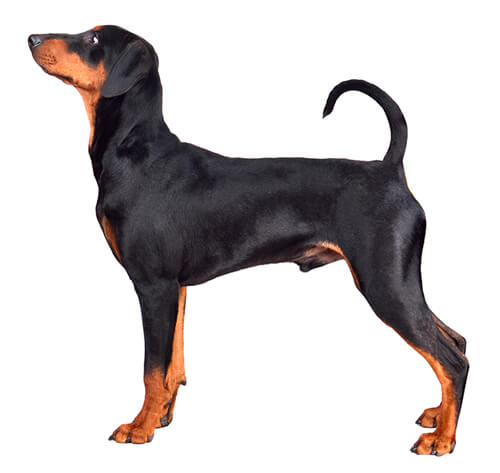
The muscular, powerful German Pinscher is courageous and protective, making him an excellent family watchdog. Originally bred in Germany, the German Pinscher has a strong prey instinct and likes to chase anything that moves. An intelligent, active breed, he needs vigorous daily exercise as well as companionship to avoid becoming bored and destructive. His dense, glossy coat is easy to maintain.
DID YOU KNOW? The German Pinscher nearly became extinct following both World Wars. Werner Jung is credited with reviving the breed in 1958 in West Germany. Despite his name, the German Pincher is more closely related to the Schnauzer than the Doberman or the Miniature Pinscher.
ALSO KNOWN AS: Deutscher Pinscher
The need-to-know
- Dog suitable for owners with some experience
- Some training required
- Enjoys active walks
- Enjoys walking one to two hours a day
- Medium dog
- Some drool
- Requires grooming once a week
- Non hypoallergenic breed
- Very vocal dog
- Guard dog. Barks and alerts
- May require training to live with other pets
- May require training to live with kids
Personality

An alert, bold breed with natural guarding tendencies, the German Pinscher needs an active home with experienced owners, who can socialize, train and handle him. This high-spirited dog would run rings around a first-time owner! In the right home, he makes a loyal, rewarding dog that can be trained in a number of disciplines.
History and Origins

The German Pinscher dog breed is of the same origin as the Dobermann, which is larger, and the Miniature Pinscher, which is smaller. A farm dog, with his forefathers working as far back as the 15th century, the German Pinscher was used as a watch dog and ratter. Originally, there were two coat types – and the Standard Schnauzer is thought to have developed from the rough-coated Pinscher-type. The German Kennel Club recognised the German Pinscher in 1879.
Nutrition and Feeding

Your dog's diet needs to have the right balance of all the main nutrient groups including a constant supply of fresh water. It's also important to conduct regular body condition scores to ensure you keep your dog in ideal shape and remember to feed him at least twice daily and in accordance with the feeding guidelines of his particular food.
Exercise

Around an hour's exercise is needed per day, though he will happily accept more if you can offer it. Agility, obedience, tracking and other doggie sports will be enjoyed, too.
Other Information

Health and Common Issues
As with many breeds, the German Pinscher can suffer from various hereditary eye disorders, and hip dysplasia (a condition that can lead to mobility problems). Eye testing and hip scoring of dogs prior to breeding is therefore important.
Best Family Dog Breeds
While many dogs are traditionally thought of as being good with children, all dogs and children need to be taught to get on with and respect each other, and be safe together. Even so, dogs and young children should never be left alone together and adults should supervise all interactions between them.